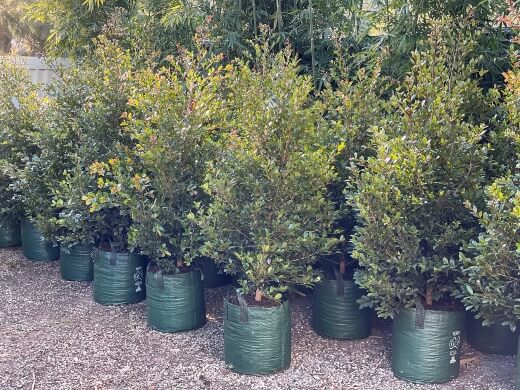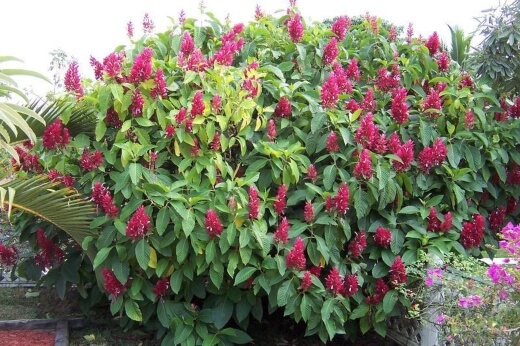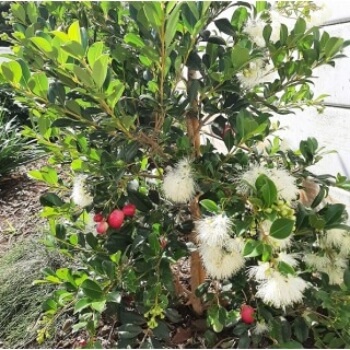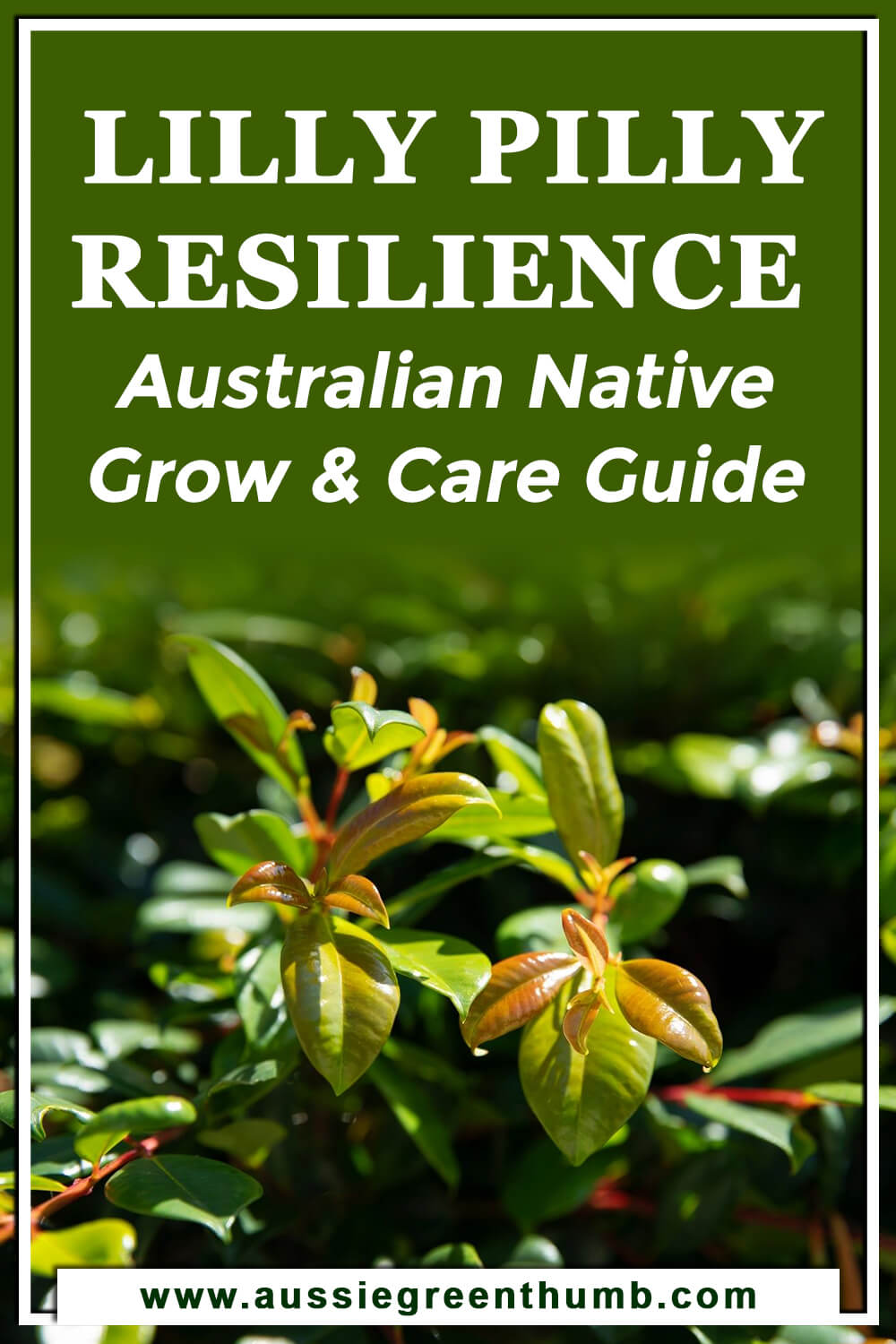Syzygium australe is one of the most popular and widely planted Lilly Pilly plants and it has two main cultivars, namely the Select and Resilience varieties. The Lilly Pilly Resilience cultivar stands out thanks to its glossy-green foliage and excellent hedging and screening applications.
An all-around decorative and robust plant, this cultivar is perfect for anyone looking to establish a perky lilly pilly in their landscapes. Here is everything you need to know to grow and care for Lilly Pilly Resilience.
More...

Genus: | Syzygium |
|---|---|
Species: | S. australe |
Cultivar: | ‘Resilience’ |
Family: | Myrtaceae |
Common Names: | Lilly Pilly, Scrub Cherry |
Location: | Outdoor |
Type: | Large shrub, small tree |
Growth: | 4 to 5 metres tall, 2 to 3 metres wide |
Sun Requirements: | Full sun to part shade |
Foliage Colour: | Green |
Flower Colour: | Creamy-white |
Flowering: | Spring |
Fruit: | Pink edible fruits in summer |
Maintenance Level: | Low |
Poisonous for Pets: | Non-toxic to cats and dogs |
Resilience features broader and bigger leaves versus the Select variety, being popularised for its fast-growing habit and rich, tight glossy-green foliage and decorative fruits.
This specific lilly pilly is also a very well-known bush tucker, producing plump pink edible fruits in summer that have long been considered gourmet bush food. With so many exciting applications, this plant is an easy choice for any gardener regardless of experience.
Getting to Know Lilly Pilly Resilience

Source: oxleynursery.com.au
As its name suggests, this plant was cultivated to be resistant to psyllid bugs, which are known to affect many of the other plants in this genus.
Commonly known as Scrub Cherry, this plant was also bred to cope with our unique climates and conditions, allowing this stunning cultivar to fit into and thrive in any Aussie garden, whether native or more orthodox.
Syzygium australe is a part of the Myrtaceae family which consists of rainforest trees native to eastern Australia. These trees naturally thrive in warm and tropical conditions along the coast, but cultivated types like Lilly Pilly Resilience have been bred to thrive in basically any of our endemic conditions.
Growing to around 4 to 5 metres tall and 2 to 3 metres wide, this versatile plant can be used as a native hedging and screening option or it can be planted as a stand-alone feature for topiary and other garden projects.
Growth is considered speedy in good conditions and this plant will generally add a striking backdrop to any outdoor space.
Special features of Lilly Pilly Resilience include:
- Glossy-green foliage
- Bronze new growth
- Fluffy creamy-white flowers that attract local animal life
- Decorative pink edible fruits with many culinary applications
- Foliage that grows to ground level when well-maintained, making this plant one of the most popular Lilly Pillies for hedging and screening
- Resistant to psyllid bugs and tolerant to climate conditions
- Can be clipped regularly for hedging and screening or can be left unclipped where it will grow as a small, conical and ornamental tree
How to Grow Lilly Pilly Resilience

Source: springcolours.com.au
Much like many of the lilly pillies in this genus of plants, Resilience requires very similar growing conditions and can also be propagated in very similar ways.
This plant is a specific cultivar meaning to grow a true to type plant, you will need to purchase a young and healthy plant from a reputable local nursery or an online supplier.
Growing from seed is not recommended for hybrid cultivars such as lilly pilly resilience.
Ideal Conditions when Planting Lilly Pilly Resilience
Thanks to its robust and adaptable nature, this plant is pretty tolerant of a wide range of growing conditions. However, it will respond well and grow best given certain positions in the garden.
Best Lighting for Scrub Cherry
Full sun positions are preferred for better growth and overall appearance. But this plant can also grow in more shaded positions as well. A decent amount of sun each day with more shady afternoons should be perfect.
Soil Conditions
Rich and well-draining soil is preferred when growing any lilly pilly. Try to avoid using heavy soils as these plants don’t respond well to sitting in thick and wet soil.
To give your soil a boost, you can add some organic compost for extra nutrients and some peat moss for better drainage.
(We previously endorsed peat/sphagnum moss. Yet, in consideration of its environmental repercussions, we've changed our recommendations to prioritize more sustainable alternatives that yield equivalent or superior results. Refer to our guide for an in-depth look at peat moss and its substitutes.)
Temperature & Humidity Levels
Generally, normal garden humidity levels and temperatures should be just fine for this cultivar to thrive. Long exposure to frost should be avoided and you can always boost humidity levels by regularly mulching and misting your plant.
Propagating Syzygium ‘Resilience’ Using Cuttings

Source: thebamboojungle.com.au
Cuttings from the current season’s growth can be taken in summer from a healthy and disease-free donor plant.
- Using a sharpened and sterilised pair of scissors or garden shears, take a 10 to 15 centimetre cutting of new semi-hardwood growth from the parent plant.
- Remove the lower leaves from your cutting and trim back the remaining leaves to about halfway.
- Let the cutting dry for a few days and callous.
- Once dried, dip the planting end of your cutting into some rooting hormone then place it into a prepared container or pot filled with rich, well-draining potting soil. Try to ensure your container has good drainage as these plants don’t respond well to sitting with wet feet.
- Water well after planting your cutting then place it in a warm location that gets bright but indirect light.
- Keep the soil moist as the cutting develops new roots.
- Let your cutting establish itself for a few more months before transplanting it into its forever home.
Planting Lilly Pilly Resilience Nursery Plant
Purchase a young and healthy seedling or plant from a reputable nursery or online store to grow a true to type Resilience cultivar. These plants arrive ready for transplanting and should strike fairly quickly once they start to grow.

Source: oxleynursery.com.au
- Choose a spot in your garden that gets full sun to part shade.
- Dig a planting hole that is about twice as wide and to the same depth as the root ball of your plant.
- Gently remove the nursery plant from its current container and lightly tousle the roots loose to remove old soil.
- Gently position the plant or seedling in your hole until the entire root ball is sitting snug then slowly backfill with soil.
- Once in position, gently firm the soil around the roots with your palm, being careful not to overly compact it.
- Water well after planting and keep the soil moist for the first few weeks while the young plant establishes new roots and growth.
- After the first few weeks, you can consider applying an organic mulch near the base of your plant for added nutrients and moisture control in the soil.
- Feed with a balanced fertiliser during growing seasons to encourage rapid, healthy growth.
- Try to ensure young plants are protected from strong winds or intense sun during the first couple of weeks.
Lilly Pilly Resilience Care Tips
Cultivated to provide growers with a low-maintenance and pest-free plant, this cultivar shouldn’t require much hassle, especially once it is established in your landscape.
Lilly pillies can take around 3 to 5 years to fully mature depending on the conditions.

Source: au.nextdoor.com
Watering Needs for Resilience
Regular and deep watering will be needed as the plant establishes itself. Thereafter, it will be more tolerant to drought where moderate and supplemental watering is recommended, especially in hot and dry spells and during its active flowering and fruiting seasons in spring to summer. It is important to avoid overwatering.
Pruning Requirements
Lilly pillies are known to respond very well to pruning and this cultivar is no different. It can be frequently clipped for dense and compact growth and a tidier appearance, especially when used as a formal hedge or screen.
It can also be left unclipped where it will grow more like a small and conical tree. Prune after the flowering seasons.
Refer to our guide on how to grow a lilly pilly hedge here.
What Fertiliser to Use
Fertilise your plant with a native and balanced slow-release fertiliser in spring to encourage bountiful blooms and fertile fruits.
General Cleaning
Fallen fruits and spent flowers will need to occasionally be cleaned up around your plant, especially after the growing seasons. To completely avoid fruiting, you can prune off old flower heads which will stop any fruits from being produced.
Syzygium ‘Resilience’ Lilly Pilly Hedging & Screening
As mentioned, this plant was specifically cultivated for its excellent hedging and screening applications. The attractive foliage grows to the ground when maintained well and the decorative flowers and fruits can make for a beautiful and lively hedge.

Source: plantsinabox.com.au
Here are some quick tips when considering hedging and screening:
- Plant 50cm to 1 metre apart with an average spacing of 75cm between each plant for the best results.
- Dig a planting trench rather than individual planting holes for a sturdy and seamless looking hedge or screen.
- Prune regularly to maintain compact and dense growth.
- Add compost and other organic matter to your plants each growing season. Feed with a slow-release fertiliser.
Syzygium ‘Resilience’ Bush Tucker Guide
We have covered an in-depth bush tucker guide for Syzygium australe. The Resilience cultivar naturally produces the same fruits. Other than having many health benefits and containing many beneficial nutrients, this plant does produce some of the tastiest fruits of all the lilly pillies.

Source: advancedplants.com.au
After flowering, the creamy-white flower heads will eventually turn to pink elongated fruits in summer. These fruits look similar to berries and are therefore known as riberries.
They feature a crisp and fresh texture with a slightly sour flavour profile that works perfectly in many fruit-based dishes like jams, jellies, sauces and other culinary condiments.
Alternatively, the fruits can also be eaten fresh after a quick rinse.
- Pick fruits straight from the branches after flowering from early December to mid-January.
- Wash them for immediate use or store them in plastic bags or containers in the fridge or freezer for use at a later stage.
- Ripe fruits will appear candy-pink and plump.
- Riberries keep for up to 3 weeks in the fridge and up to 2 years when frozen.
- Each fruit will contain one seed and the flesh and skin around the seed can be eaten.
Be sure to check online for many amazing and tasty recipes using these native fruits.
Possible Lilly Pilly Resilience Pests, Problems & Diseases
Due to the fact this cultivar was specifically developed to be resistant to many of the usual lilly pilly pests and diseases, you shouldn’t run into any severe issues when establishing your plant.
Overwatering or underwatering can lead to root rot issues so as long as you have a good grip on your plant's watering needs, you should have a healthy and happy plant for years to come.
Lilly Pilly Resilience Frequently Asked Questions
Are Lilly Pilly Resilience roots invasive?
Their root systems are generally considered non-invasive so planting near paved areas or buildings should be fine. Fallen fruits can pose a problem near pools so that may be something to consider.
How do you prune Lilly Pilly Resilience?
Pruning frequency can vary depending on the growing climate but generally, these plants can be lightly pruned following a growth flush. If needed, they can also be hard pruned to avoid an unruly and out of shape appearance.
Is Lilly Pilly Resilience fast-growing?
Yes. This cultivar grows fast and compact with light-green foliage and reddish-bronze new growth. While they usually grow to around 4 to 5 metres tall, they can also be pruned to a smaller shape and size. Leave unclipped for maximum height
For more in-depth information on growing and caring for Australian native plants, be sure to refer to our other useful guide below:

Wrapping Up Our Lilly Pilly Resilience Guide
An outstanding cultivar of a beloved lilly pilly, it is easy to see why this plant is such a popular choice for gardeners across the country.
With all-around attractive features, an easy-going attitude and offering many useful and ornamental applications, this special Syzygium australe cultivar is a must-have for any native or more formalised garden setting. Raise your garden's spectacle easily with Lilly Pilly Resilience.
Published on June 12, 2022 by Nathan Schwartz
Last Updated on February 26, 2024




